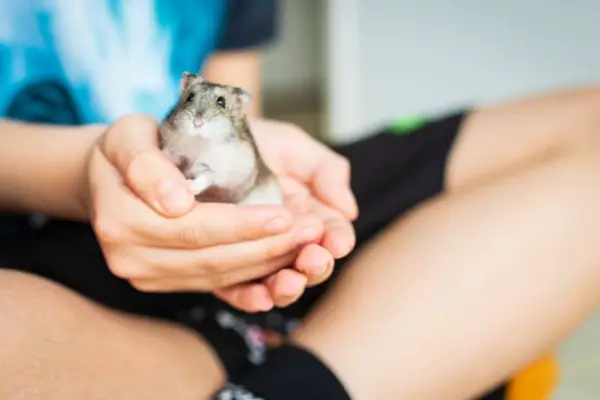Are Hamsters Easy To Take Care Of: The 13 Easy Guide Tips

Pet lovers always ask are hamsters easy to take care of, and in this post, we will discuss what you are supposed to be doing to ensure you are taking care of your hamster.
Hamsters are generally low maintenance and easy to care for when compared to other pets.
Because hamsters lick and chew on almost everything, keeping their cage clean is critical for their health.
It’s hard to deny that the hamster is one of the most popular pets in the world, thanks to its adorable faces and small size.
And while they may seem like a great pet, it can be hard to know if you’re really up for the responsibility.
This article will help you understand what it takes to care for a hamster properly and how much time is involved.
You’ll also learn about some of the best hamsters for beginners and what supplies you’ll need, so you’ll be ready when you adopt your new friend!
Are Hamsters Easy To Take Care Of?
When compared to other pets, hamsters are relatively low maintenance and easy to care for. Because hamsters lick and gnaw on just about anything, keeping their cage clean is essential for their health. It is critical to provide excellent care for your hamster.
You might not have even considered hamsters before, but after one looks at their adorable faces, you can change your mind.
But can these tiny animals really be as easy to take care of as they seem? Thankfully, the answer is yes! Hamsters are great pets for kids about 6 years and adults alike.
They are super small, so they don’t need a big cage or lots of space to run around.
All the hamsters need is food (mostly seeds and vegetables-but many foods are available), water, bedding, and a wheel.
How to care for a hamster
Here are all the common tips on how to care for a hamster you should know and practice:
Learn how to handle a hamster with care
Hamsters and gerbils, unlike other tiny creatures, must be taken up with both hands and held in cupped palms.
The same applies for putting them down, but take additional care, so they don’t escape or slip between your fingers.
Because hamsters are naturally nocturnal, be mindful of the time of day you are attempting to handle your hamster.
You don’t want anyone stealing you from your hamster because it escaped from home.
Set up the right hamster cage
Hamsters come in different sizes ranging from Syrian hamsters may reach 5-7 inches (12.7-17.8 cm) in length as adults.
Dwarf Campbell hamsters and Dwarf Winter White hamsters reach 3-4 inches (7.6-10.1 cm).
Chinese hamsters can grow to be 4-5 inches (10.1-12.7 cm) long.
Roborovski hamsters barely reach 3 inches (7.6 cm) in length as adults.
Choose a cage that is large enough for your hamster, is escape-proof, and is simple to clean.
While prefabricated cages with tubes are entertaining, they may be difficult to clean and have inadequate ventilation (and the tubes can be too small for some Syrian hamsters).
Never ignore a hamster’s capacity to escape, since it can fit through very small openings and gnaw through plastic walls very rapidly.
If you purchase a Syrian hamster, bear in mind that many hamster cages are on the tiny side.
If you buy a dwarf hamster, keep in mind that they can often fit through the bars of an average-sized hamster cage.
Purchase a cage that is at least 15 inches in length by 12 inches high, but preferably something larger to allow your hamster more space to exercise and explore.
Make certain that the cage is likewise escape-proof.
Once a week, thoroughly clean the hamster cage.
While the cage is being cleaned, safely remove the hamster and place it in a secure area.
Set up the right hamster bedding and nesting material
Avoid using cedar and pine-wood chips as bedding for your hamster; the odor might be unpleasant to the respiratory systems of hamsters.
If you want wood bedding, aspen is a safer alternative, although many individuals prefer paper or other fiber-based bedding.
Hamsters enjoy resting in a comfortable nest; cotton nesting materials sold in pet stores are unneeded and might create issues if eaten or twisted around their toes.
Shredded toilet paper or face tissues make great nesting materials that are very inexpensive.
Avoid cat litter, corn cobs, newspaper, and any scented bedding in favor of bedding produced from cellulose or plant-based paper fibers (which contains chemicals that can cause respiratory trouble).
There should be at least 6 inches of bedding on the ground. This may appear to be a lot, but in the wild, hamsters construct enormous tunnels.
Many hamsters will not dig if there is insufficient bedding, so always add a thick layer.
During the weekly cage cleaning, bedding items can be cleaned and replaced.
Provide food daily for the hamster
Feed the hamster on a daily basis. Pelletized food, rather than muesli or seed mix, is required for hamsters to avoid selective feeding and to guarantee that your hamster receives all of the nutrients it requires.
Feed your hamster enough food each day to fill both cheeks, about 15g (1/2oz) for a Syrian hamster and 8g (1/4oz) for a Dwarf hamster.
Make sure to put new food in their bowl on a daily basis.
You can buy bags of hamster mix, which is often a mixture of fruits, veggies, seeds, and grains.
But most people recommend giving your hamster tiny bits of fresh vegetables and fruit as well.
You should also provide your hamster with fresh water at all times.
Not all greens are beneficial for hamsters, and not all fruits and vegetables are either.
Avoid onions, garlic, chives, leeks, lettuce, raw potatoes, and oranges in favor of broccoli, parsley, apple, pear, carrot, and turnips.
Because hamsters are prone to diabetes, you should offer them fruit (which is high in sugar) in moderation.
Provide lots of toys and exercise for your hamster
Hamsters enjoy running and require exercise, so invest in the largest, highest-quality exercise wheel available.
It should have a firm running surface with no cross supports.
Look for one that attaches to the cage’s side. Because hamsters run at night, make sure the wheel is silent.
A tiny quantity of vegetable oil sprayed onto the wheel axis may help protect the wheel from becoming noisy.
Your hamster should have a range of chewing and climbing objects in addition to a wheel.
Hamsters require a lot of excitement and activity to avoid boredom. Bored hamsters begin chewing through anything in sight, with the goal of escaping.
You may buy hamster-safe goods from the pet store, or you can build toys for your hamster out of toilet paper tubes and tissue boxes.
Provide clean water daily for the hamster
Keep water handy and accessible at all times, your hamster will not drink much water, but when it does become thirsty, it is critical that water be accessible.
Do not put water in a dish since the bowl will quickly become dirty, and your hamster will become thirsty and perish.
Use a water bottle or dispenser instead. To keep the water fresh, change it every day if feasible, or once every three days at most.
Cleaning the water bottle is as simple as pouring uncooked rice and a small amount of water into the bottle and aggressively shaking it.
Any algal buildup should be dislodged by the uncooked rice. Remember to empty the water container of all uncooked rice before returning it to the cage.
Clean and wash the hamster’s habitat regularly
There is a good balance between keeping your hamster’s home clean and comfortable and causing unnecessary stress by cleaning it excessively.
Take soap and water and clean out the entire habitat once it’s been cleared of bedding, toys, and other items once a week or every other week.
This extra step will keep your hamster’s environment smelling fresh:
- Every day, clean the toilet area.
- Change bedding on the spot as needed (when soiled/wet).
- Once a week, clean out their food bowl.
- Every day, change the water.
- Weekly or twice a week, empty their whole environment.
- Weekly, replace all bedding.
Bond more with your hamster
You must learn to be patient with your hamster, and you should always regularly be feeding.
Be sure to provide plenty of out-of-habitat playing, and soothing chat will all help you bond with your hamster.
Always approach your hamster carefully and learn how to speak to your hamster in a conversational tone.
Over time, your hamster will learn to identify your scent and voice and will see you as a source of comfort.
Give your hamster treats weekly
Give your hamster treats two or three times each week. There are lots of safe fruits for hamsters.
Carrots, cucumber, apples, bananas, lettuce, celery, kale, collard and dandelion greens, and a variety of other veggies and fruits are hamster favorites.
Some of these items can also be included in the regular diet of a hamster.
Hamster snacks, such as yogurt chips, hamster chocolate drops, or chunks of wood for the hamster to gnaw on, are also available at all pet stores.
Some vegetables and fruits should not be fed to your hamsters.
Onions, almonds, beans, seeded fruits, avocados, chives, eggplants, scallions, spices, leeks, garlic, iceberg lettuce, and citrus fruits are all off-limits.
Disinfect the hamster cage once in a while
At least once a week, clean and disinfect the hamster habitat and its contents with a 3 percent bleach solution.
Rinse the cage and habitat very well and allow drying fully before reintroducing the hamster to its home.
Remove damp areas on a daily basis, and replace bedding at least once a week, or more frequently if required.
Respect your hamster resting and sleeping time
Your hamster sleeping time must be respected. Even though hamsters are nocturnal creatures, they do move about throughout the day to seek food and other necessities.
Even if it appears to be awake, it is not in the mood to play unless you notice it differently. Similarly, limit the number of individuals who come into contact with the hamster.
It’s critical that the hamster exclusively bonds with you for the time being, as it will have lots of other companions afterward.
But it needs to know that you’re its friend and that you’ll never hurt it.
Provide your hamster with chew sticks
Provide your hamster with a chew stick in a reasonable amount or quantity.
These are available in a variety of sizes, colors, and tastes.
Because your hamster’s teeth are continually growing, it will need to grind them down gradually.
This is when chew sticks come in handy. Continue to try new ones until you discover one that your hamster likes.
All chew sticks are avoided by certain hamsters. If this is the case, expect your hamster to gnaw on other items in its environment, such as the cage bars.
Keep human foods far away from your hamster
Be sure to keep all human foods far away from your hamster.
Candy, pasta, raw meat/fish, sweets, and desserts are all examples of food to keep away.
Diabetes can occur in hamsters. Sugary foods that you might not think are high in sugar will be too sweet for your hamster.
This might be harmful to their health, I hope this explanation has answered your question are hamsters easy to take care of!!!
More recommended article on hamsters:
- Are Hamsters Dangerous: 12 Bad Things About Hamsters.
- Are Hamsters A Good Pet: 24 Hamster Pros & Cons.
When to take a hamster to the veterinarian
If you observe any of the following symptoms, take your hamster to the vet right away:
- If your hamster stops eating or drinking
- If your hamster is sitting in a hunched-up position
- If your hamster appear to look sunken or dull looking eyes
- If your hamster is disinterested at times when normally active
- If your hamster is drinking lots of water
- If your hamster produces wet faeces and/or diarrhoea (which may lead to soiling of his/her rear end)
- If your hamster have discharge from the nostrils, eyes, vagina etc.
- If your hamster have persistent sneezing or coughing – hamsters are highly susceptible to strains of the human cold virus
- If your hamster have difficulty in walking or unsteady balance
- If your hamster is not using a limb
- If you notice persistent scratching, especially if focused on one area
- If your hamster suddenly become more aggressive than usual
- If you notice firm, warm and swollen stomach
- If you notice any injuries or abnormal lumps.
General symptoms of a sick hamster
Here are the general symptoms of a sick hamster:
- Weight loss
- abnormal hair loss
- diarrhea or dirty bottom
- distressed breathing
- lethargic
- eye or nasal discharge
- skin lesions
- overgrown teeth






